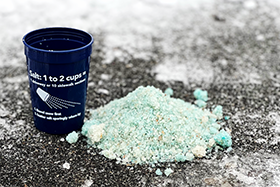Reducing and managing salt use
Keep your home safe while protecting the environment.
Image

Clearing snow and ice at your home
- Avoid ice build-up by clearing snow from driveways and walkways as soon as possible.
- Don’t pile your snow where it could melt across paved areas and re-freeze to create a slipping hazard.
- Keep water from turning into ice by cleaning and repairing eaves troughs and clearing storm drains.
- Make sure downspouts are directed away from driveways and walkways.
When applying salt, consider these tips:
- Before snow falls or temperatures drop to freezing, apply a small amount of salt across your driveway to help prevent ice and snow from sticking.
- After a snowfall, salt should only be used once the snow is removed and only in areas needed for safety.
- Salt only melts ice and snow at temperatures above -10C. When it’s too cold for salt to work, alternatives such as sand, grit, non-clumping kitty litter or magnesium chloride can be used. Although these products don’t melt ice, they can be used for traction to avoid slips and falls.
If you hire someone to clear your driveway, look for contractors that are Smart About Salt.
Winter safety tips
- Reduce the risk of slipping and falling by dressing for the weather and wearing boots with good treads. Consider adding ice grippers to shoes and boots for extra grip.
- Install winter tires to give you better traction when driving in winter.
- Reduce your driving speed to give you more time to react to winter road conditions.
- Keep distance and give right-of-way to winter maintenance vehicles.
- Drivers need to give cyclists extra space in snowy weather conditions.
- Plan and give yourself more time to get to your destinations.
How salt impacts the environment
Salt is used on roads, sidewalks, parking lots, and driveways to help make winter driving and walking conditions safer. However, when snow and ice melts, the salt doesn’t disappear. It mixes with water from rain and melting snow and makes its way to our rivers and lakes. Over time, this harms our environment, wildlife, and quality of our drinking water.
Salt Management Plan for Peel
Our Salt Management Plan guides how we use salt efficiently while ensuring safe driving conditions for travellers.
- Weather monitoring and forecasting with Road Weather Information Systems (RWIS)
RWIS helps us anticipate weather events as they approach Peel, allowing us to select the most effective winter road maintenance application. - Snow storage facility
If there are consecutive large snow events in a winter season, snow may need to be removed from roadways and stored in a separate facility. This dirty snow can be handled in an environmentally responsible way by ensuring it melts slowly and is treated before being released into the environment. - Improved salt storage and handling
We follow best practices for salt storage and handling to ensure that we have enough product on hand, while protecting it from rain and snow. - Route planning
Route planning helps save time and money and reduces environmental impacts by using anti-icing techniques more efficiently.